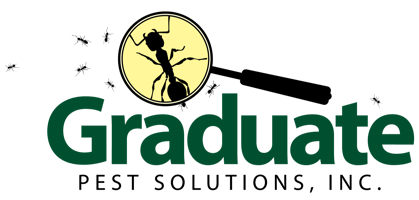In the late days of summer, there’s a common call we get: a wasp nest is causing trouble. In too many instances, the call to us is not the first step a homeowner takes. Handling a wasp nest on your own is doable, but dangerous. If you are going to try and tackle the angry little nuisances yourself, there are some things you should be aware of. We’ll cover some of the need-to-know so you can know when you need-to-go.
What kind of wasp is this?
Identifying the type of wasp that you’re contending with can help determine exactly how dangerous trying to remove a nest by yourself can be.
- Bald-faced hornets make their nests out of paper carton. They’re usually elevated, attached to a tree, awning, gutter, or power pole. They can be sizable, growing up to two feet long. These stinging insects are somewhat beneficial because they can control other pests on your property, however they are territorial and will protect their nest.
- European hornets will build their nests out of paper carton as well, however the exterior in enveloped in a brown protective layer. Their nests are also somewhat more “built in,” typically being hidden in hollow tree, tucked under an overhang, or in a hollow wall. Similarly, European hornets will defend their nest.
- Mud daubers build their nests in wet earth like their name implies. While they are solitary, they still pose a threat if handled.
- Paper wasps get their name from the material they make their nest out of. Their nests are one of the most easily identifiable because of their exposure in the air. They also are the most likely to sting if their nest if disturbed.
- Yellowjackets are the iconic and easily identified yellow and black striped wasp. Their nests can be aerial or build near the ground, or in the ground sometimes not being noticed until you’re entirely too close.
What are wasp nest removal musts?
If you’ve identified the type of wasps you’re up against and are confident you want to DIY, there are a few things we recommend to set yourself up for success. First, it’s always best to try and remove a wasp nest when it’s small. While not always possible, it’s much easier to tackle a nest the size of a baseball instead of one as big as a basketball. At this point in late summer, it’s likely the nest is on the larger side. It’s always best to check your property in late spring and early summer to find the nests while they are small and easier to treat and remove.
Most homeowners do not have a beekeeping suit lying around. However, protection is still important so you can wear certain things to give yourself more protection: a heavy, hooded coat, thick gloves, long socks pulled over pant legs, and face covering. Do your research when choosing a pesticide to ensure it’s effective against wasps so you’re not just annoying them.
Finally, consider if the nest poses a threat. Almost all wasps will not bother humans unless the nest is threatened. If the nest is attached to an overhang with high traffic, then removal is necessary. However, if the nest is in low traffic, out of reach areas, consider leaving it be as wasps are beneficial insects.
What’s the BEST way to remove a wasp nest? Prevent them in the first place.
Things that draw wasps to your property are commonly food sources—wasps love proteins and sugar. For your home, this can be bird feeders, compost heaps, and trash cans. Seal outdoor containers and remove potential food sources. Some wasps will make their nests INSIDE your home in hollow walls or attics. Ensure your siding, screens, and foundation are sealed to prevent access.
Over-the-counter solutions for nest prevention come in two forms. The first of which is fake wasp nests! As we’ve indicated, most wasps are territorial and won’t “set up shop” so to speak if another nest is present. Also, many homeowners think of pesticides for wasps as reactionary. However, there are pesticides that serve as preventative solutions. Please, always read the product label to ensure applications are safe.
Of course, we always recommend calling in a professional for the ultimate safety. Stinging insects send half a million homeowners to the emergency room each year. Whether you call Graduate or someone else, a good pest control professional will have the tools and techniques to keep you and your family safe.
Download Our Guide to Stinging Insects
Fly in your ointment? Our team at Graduate Pest Solutions specializes in prevention. Call us at 413-566-8222 or contact us with any questions or if you are experiencing a pest problem. We have the knowledge and service necessary to help keep your home and workplace pest-free!
YOU MAY ALSO LIKE
These related articles

